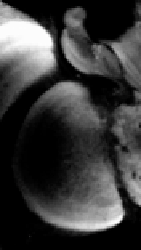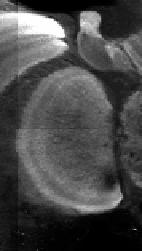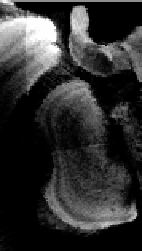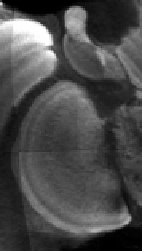Biomedical Engineering Reference
In-Depth Information
(a) Reference
image
(b) Floating
image after rigid
registration
(c) Floating image
after
unconstrained
non-rigid
registration
(d) Floating
image after
constrained
non-rigid
registration
Figure 11.5:
Illustration of the importance of constraining non-rigid registra-
tion. These microscopy images are magnified to focus on the area of the right
lobula (compare Fig. 11.1 for an anatomical overview). In the reference image
(
a
), the lobula appears substantially darker on the lateral side (
ellipse
). In the
rigidly registered floating image (
b
) from another individual the lobula has a
more homogeneous intensity. Without smoothness constraint, intensity-based
non-rigid registration (
c
) computes a grossly incorrect deformation (
arrows
). A
constrained non-rigid registration (
d
) does not have this problem.
a weighted sum of the data-dependent image similarity and the regularization
constraint term:
E
total
=
(1
−
w
)
E
NMI
+
w
E
constraint
.
(11.4)
In detail, we constrain the deformation to be smooth by adding a bihar-
monic penalty term, which is based on the energy of a thin plate of metal that
is subjected to bending deformations [4, 78]. The penalty term is composed of
second-order derivatives of the deformation, integrated over the domain
D
of
the transformation
T
as follows:
∂
2
∂
2
∂
2
2
T
∂
x
2
2
T
∂
y
2
2
T
∂
z
2
E
constraint
=
+
+
D
∂
2
2
∂
2
∂
2
T
∂
x
∂
y
2
T
∂
y
∂
z
2
T
∂
z
∂
x
+
2
d
x
.
(11.5)
+
+







